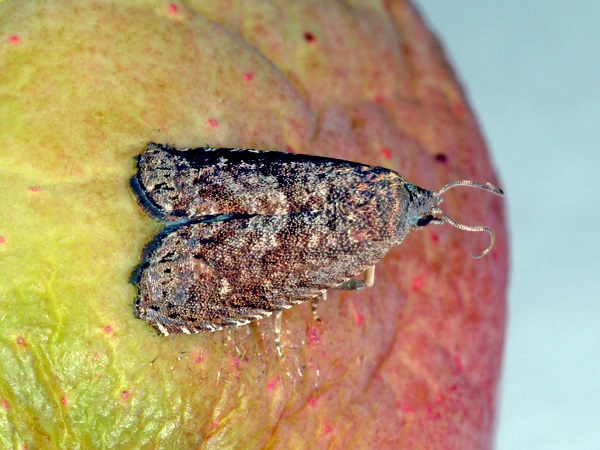Oriental Fruit Moth
ENTFACT-212: Oriental Fruit Moth | Download PDF
by Ric Bessin, Extension Specialist
University of Kentucky College of Agriculture
The oriental fruit moth is one of the most serious pests of peaches in Kentucky. Early in the season, this insect damages succulent terminal growth and attacks fruit in mid-summer. Although there can be six to seven generations each year, it is the second and third generations that cause most of the damage. In addition to peaches, this insect attacks apple, plum, cherry, pear, and rose.

Figure 1. Oriental fruit moth is monitored with pheromone traps and can be quite numerous.
The oriental fruit moth is a small (1/4 inch), charcoal-colored, nondescript moth. Fine alternating bands of light and dark lines on the wings give it a mottled appearance. The small, flat, oval eggs are laid individually or in small clusters on the foliage primarily, usually on the upper leaf surfaces of the terminal growth. The larva is pinkish white with a brown head and is 1/2 inch long when full grown. The larvae pupate in a silk cocoon in crevices in the bark or in litter at the base of the tree.
The oriental fruit moth overwinters as a full-grown larva in a cocoon in protected places on the trunk or around the base of the tree. They pupate beginning in late March and moth emergence usually coincides with peach bloom. First generation larvae tunnel into the young, tender, terminal growth near the base of a leaf early in the season. The larvae may tunnel down the center of the twig for 2 to 6 inches before completing development or exiting and moving to another shoot. Successive leaves begin to wilt as the larva progresses down the twig. This injury causes dieback or flagging of these twigs. Larvae often damage 2 or 3 twigs before reaching maturity. These larvae can complete their development in less than a month.
Larvae of subsequent generations feed on fruit, when available, and twigs. As the twigs harden, the partially grown larvae leave them and enter the fruits to feed. Larvae commonly bore right to the center of the fruit and feed around the pit. Larvae feeding on the fruit often causes it to drop. These wounds serve as sites for development of rots. Young fruit often exude gum from the entrance and exit holes left by the larvae. Damaged fruits that remain on the tree are distorted. Occasionally, the larva may tunnel into the fruit through the stem. In such instances there may not be any apparent evidence of how the larvae entered the fruit after it is harvested.
Management
Pheromone traps are available for this insect to monitor moth activity and effectively time sprays. Traps are placed in the inside of the tree at eye level or higher just before bloom. One trap per ten acres is recommended for commercial orchards, with a minimum of two traps. For backyard trees a single trap can be used and an insecticide treatment is made at petal fall if the insect is detected. Commercially, we use a threshold of 7 moths per trap per week to indicate the need for control. Sprays for the first generation should be applied 6 days after peak flight which coincides with peak egg laying, or using the degree day model available on line through the UK Ag Weather Center. This often coincides with the time for plum curculio control. Sprays for the second and third generations need to be applied 3 days after peak flight. Depending on the anticipated harvest date for the fruit, sprays for the third generation may need to be adjusted or omitted in order to meet the necessary pre-harvest intervals (PHI) requirements for certain insecticides.
Some producers in Michigan and on the West Coast have successfully adopted mating disruption strategies for oriental fruit moth management in peaches. With mating disruption, pheromone (sex attractant) dispensers are placed throughout the orchard. As the pheromone is released from the dispensers, male moths that normally use the pheromones to locate females become confused. This interferes with the mating process. Approximately 400 of the twist-tie dispensers are used per acre and are placed in the mid to upper level of the tree canopy. Pheromone traps are used to evaluate the effectiveness of the mating disruption. If mating disruption is working, the pheromone traps should catch no moths. Mating disruption is only recommended for orchard of 5 acres or larger in size.
Examine trees regularly in the early spring for signs of wilted shoots. Examine wilted shoots carefully to determine if oriental fruit moth was the cause of the injury. Young trees with vigorous new growth are often very susceptible to injury by this insect. Oriental fruit moth prefers to feed in the tops of trees. Detection of early season shoot damage indicates the potential for fruit damage by later generations.
Revised: 11/19
CAUTION! Pesticide recommendations in this publication are registered for use in Kentucky, USA ONLY! The use of some products may not be legal in your state or country. Please check with your local county agent or regulatory official before using any pesticide mentioned in this publication.
Of course, ALWAYS READ AND FOLLOW LABEL DIRECTIONS FOR SAFE USE OF ANY PESTICIDE!
Photos courtesy Ric Bessin, University of Kentucky Entomology
